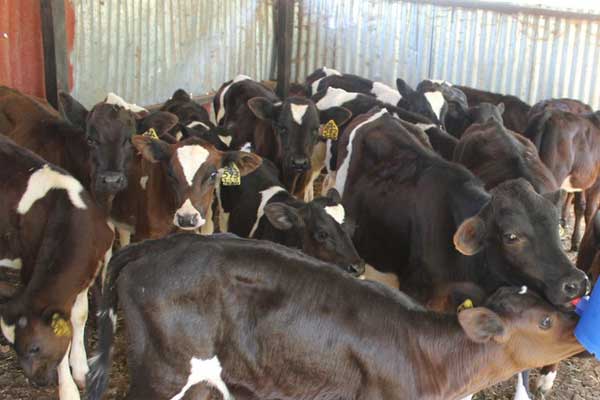The calving period is the most stressful for the cow and for the farmer. It all starts with the cow-calf operation, whose basic components must be adhered to without which both the cow and the calf cannot survive.
What can you do in advance to prevent calving problems?
Feed a balanced diet during pregnancy. You have to provide supplementary minerals and vitamins during the last two months of pregnancy. Beware that a straw-only diet can reduce colostrum quality in your cow.
Control infectious diseases
Discuss the appropriate vaccination and disease eradication strategies for your herd with a veterinarian. Beware that stillborn, weak or sick calves can also be caused by diseases.
Dry off your cows two months before calving
Drying off means the animal should be milked a final time, then not again until the next birth and lactation. It is advised that you dry off cows for 45 to 60 days. This will allow a cow sufficient time to rest and regenerate mammary tissue. If animals have prolonged dry periods, they run the risk of becoming obese and having difficult calving.
How can you manage your calving to reduce calf losses?
Calve all heifers and cows in a calving unit or clean pasture. Animals in advanced pregnancy must be separated in clean pasture pens or calving boxes, which must be properly disinfected, bedded with clean, soft and absorbent litter with adequate supply of fresh water.
Farmer should observe calving process if possible
Even though calving is a normal physiological process, it requires due care at all stages by the manager of the herd. If cows are showing signs of calving, keep a discreet eye on them every two hours.
There are three stages to the birthing process, or parturition. These are dilation of the cervix, delivery of the calf and delivery of the placenta. Knowing the normal birth process will help you decide whether or not to intervene.
Stage 1: Dilation of the cervix. You might not even notice this stage, which may take days to complete. Uterine muscular activity is quiet during this stage as the cervix softens, and the pelvic ligaments relax. At this time, you may see thick clear mucus “string” hang from the vagina. You may notice the cow’s appetite decreases and she may prefer to be off by herself. Uterine contractions begin by the end of stage one, pushing uterine contents against the cervix, causing further dilation.
Stage 2: Delivery of the calf. This stage officially begins with the appearance of membranes (water bag) at the vulva.
Start your clock at this time: traditional texts say the calf should be delivered within two to five hours of the moment you first see the water bag. More recent research has found that healthy heifers with normal calf presentation will calve unassisted within an hour of the start of stage two.
Normal birthing is either anterior or posterior. Anterior presentation is of the head (nose) and two front feet with the spine of the calf resting against the underside of the cow’s spine.
Posterior presentation is one of two rear feet and a tail; with the spine of the calf resting against the underside of the cow’s spine. If the presentation is normal, you may allow the cow to labour for between 40 minutes to an hour, especially if the water bag is still present around the calf.
Stage 3: After calving:
Expulsion of placenta. The placenta should be shed within eight to 12 hours of the calf’s delivery in normal cases. If retained (by definition, placenta not shed after 12 hours), do not forcibly remove it. Get the help of veterinarian.
Care with regard to milking of cow:
When starting to milk after calving, ensure that all blockages from teats are removed. A cow may be milked three times a day until inflammation disappears from the udder.
‘Golden Hour’ after giving birth:
The cow licks clean her new-born. This helps with mother–baby bonding, and gives the new-born some “get up and go”. The new-born then attempts to stand. This is followed by balancing, then experimenting with moving its legs, progressing to its first steps. The new-born will instinctively “put its mouth over” a teat that touches the side of its face.
Colostrum needs to be fed within two hours after calving
Colostrum is the milk in the mother’s udders immediately after she gives birth. It provides warmth, fluids plus many nutrients, and important antibodies. The mother cow manufactures antibodies as a result of her exposure to the diseases in the environment.
Once the new-born absorbs these antibodies, it becomes the new-born’s immunity until about seven weeks of age, and until the animals own immune system takes over.
Preventing navel diseases
The new-born navel (umbilicus) is always warm and damp. Bacteria love such conditions. They can speedily travel up the umbilicus and get into the new-born’s blood. This may cause serious health problems including navel ill, joint ill, liver abscess, bladder infections and even death.
Check regularly for navel ill – handle the navel of all calves with clean or gloved hands at birth and in the first week of life to check for excessive bleeding, pain, abnormal swelling, odour or pus and treat as recommended by your local veterinarian
Did you love the story? You can also share YOUR story and get it published on Bizna Click here to get started.

